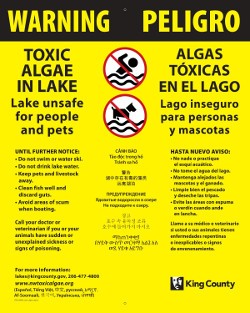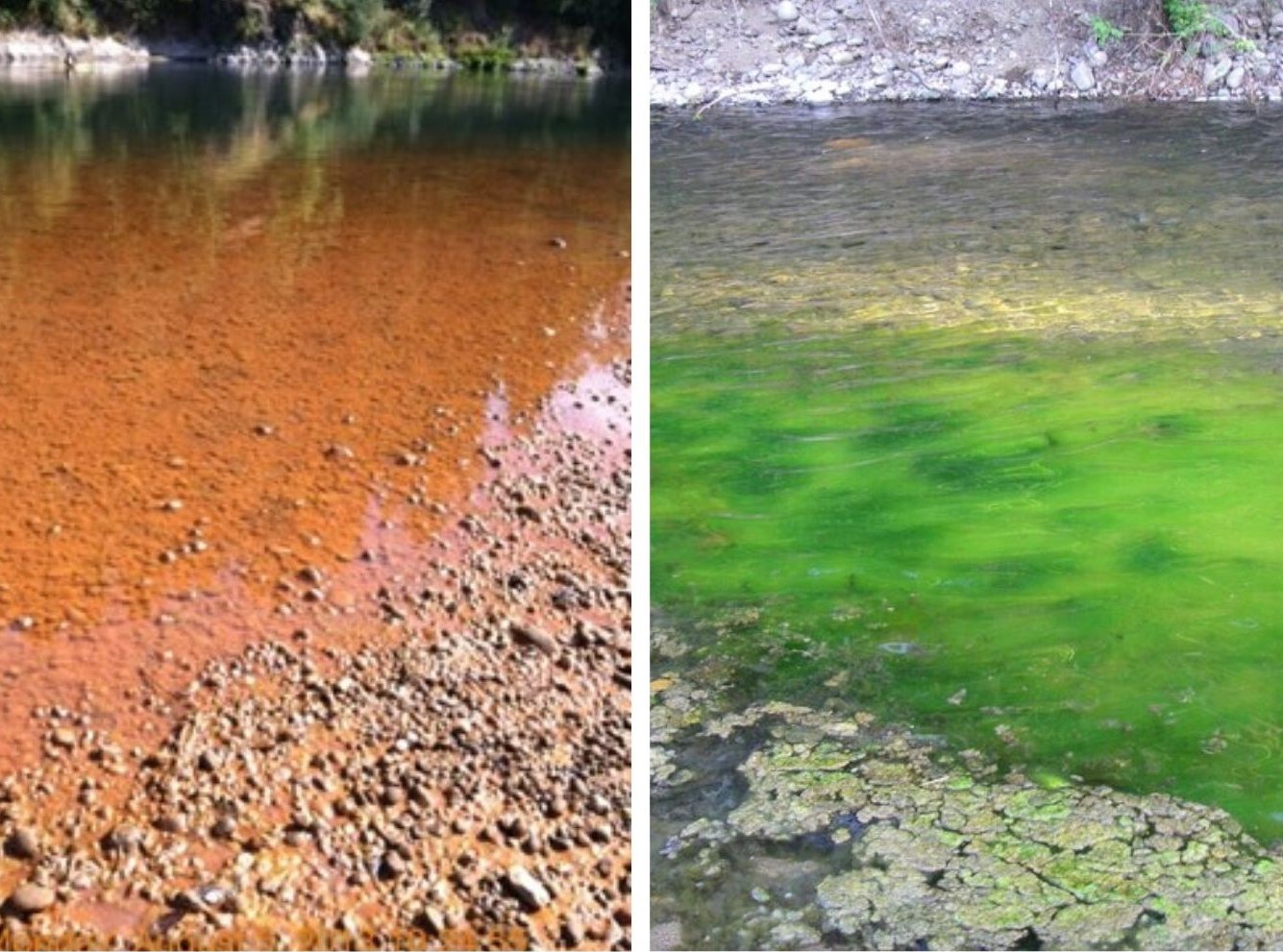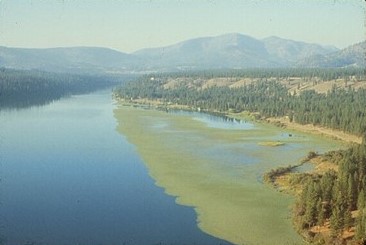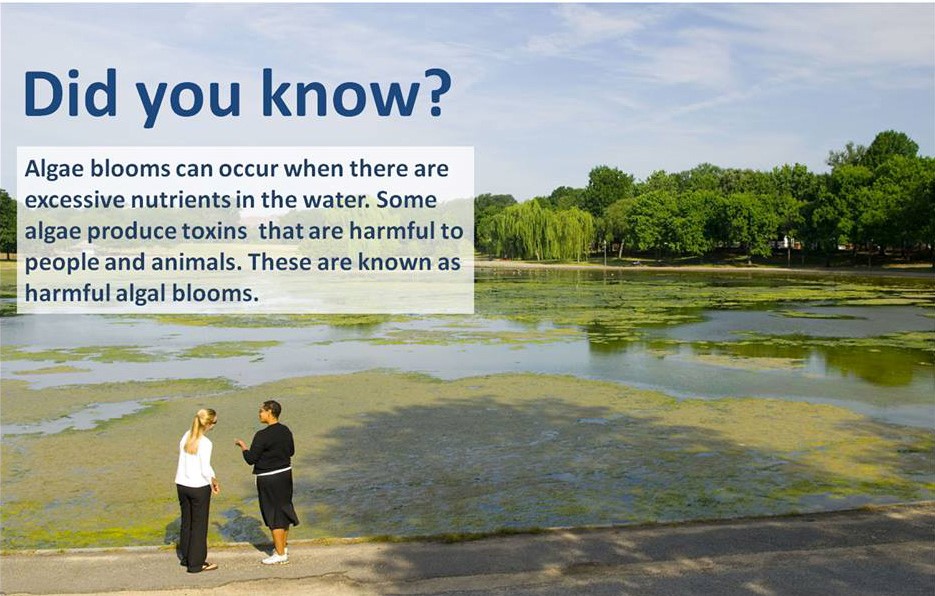As you look forward to the beautiful telltale signs of spring — flowers blooming, birds chirping — there are some less than beautiful seasonal changes that happen as well. Spring is when you can start to see harmful algae blooms in lakes across the state. These blooms are a regular occurrence in some lakes and pretty rare in others. Even if the lake in your neighborhood looks healthy and has never had a harmful algae bloom before, you should keep your eye out for the signs of a bloom. The changing climate and changes in the area surrounding a lake can create the right recipe for a harmful algae bloom.
What is a harmful algae bloom?
Warning signs can be different from place to place. Here's an example from King county.
Many lakes have algae but not all algae is cause for concern. Known by many names — blue-green algae, cynobacteria, toxic algae blooms — a harmful algae bloom is when algae with toxic strains starts to grow in freshwater. The toxicity of each bloom can vary and is difficult to predict. Toxicity can change from one day to the next. Blooms can be toxic to humans, pets, and wildlife, so it is important to be wary of any signs of a harmful algae bloom. Most importantly, if the lake you are visiting has warning or closure signs posted — pay attention!
Some amount of algae growth is normal for most lakes during the warm seasons and lakes can have blooms of algae that are not toxic. The only way to confirm if a bloom is toxic is through laboratory testing, but there are common descriptions of a harmful algae bloom to be aware of:
The color of algae blooms can vary – from blue-green, reddish-brown, or even pea soup in color
- the appearance of ‘pond scum’ on the water
- the color can vary — blue-green, reddish-brown, or pea soup in color
- can look like a paint spill on the water
Possible signs that you or your pet might have been exposed to a harmful algae bloom include:
- skin rashes after being in the water
- sudden, unexplained sickness of your pet after it has been drinking or playing in the water
If you suspect you or your pet have been exposed to a harmful algae bloom, seek appropriate medical attention. If you spot a bloom, contact the local lake manager. This could be the county public health department, city, or state park depending on the lake. As there is no statewide, comprehensive monitoring program for every lake, lake managers rely on residents to call in and report blooms to their local municipality, in addition to any monitoring the lake managers perform.
Why do lakes have blooms?
Algae bloom on Lake Spokane in the 1970s
In many instances, but not always, harmful algae blooms happen because a lake is unhealthy — with an excess nutrient load, mainly phosphorus. The excess nutrients cause algae to grow, or bloom.
The health conditions of a lake can change year-to-year, depending on what is happening around it and the weather. This can be why a previously healthy lake could experience a bloom for the first time. A single bloom doesn’t mean a lake is destined for poor health, but it is a possible indicator of problems. Here are some scenarios that could change lake health and lead to harmful algae blooms:
- Climate change and changing weather — longer dry spells that start earlier in the spring can lead to more blooms.
- Phosphorus build up in sediment — lake sediment can absorb phosphorous for a period of time, but eventually, the phosphorus will start to release for a variety of reasons, and it is hard to predict when that will happen.
- Development around a lake — when there is less vegetation due to development, more runoff pollution can travel into a lake.
- Changes in water flow — if a lake no longer has adequate inflow and outflow, this can cause stagnation and temperature increases — a perfect recipe for algae blooms.
Is it possible to prevent harmful algae blooms?
Whether or not your actions can help prevent a harmful algae bloom depends on the unique circumstance of the lake. Individually, you might not be able to undo years of nutrient build up, but there are steps people can take to prevent lake health from getting worse, including:
- Cleaning up pet waste — pet waste in a yard or on a trail can end up in a nearby lake
- Maintaining your septic system to prevent leaks
- Managing water fowl — feeding ducks can be fun but it can also lead to large concentrations of waste
- Reducing or eliminating the use of fertilizers
- Washing vehicles away from the lake or storm drains, such as on your lawn instead of the driveway
- Maintaining native vegetation around the lake — many people like the look of a lawn right up to the water’s edge but grass isn’t nearly as good at helping to keep an ecosystem in balance as more natural vegetation. (Bonus: native vegetation also attracts waterfowl, possibly keeping them off of your lawn!)
It's hard to tell if this year will be a big year for harmful algae blooms across the state. As spring and summer weather unfolds, only time will tell if lakes have the right recipe for blooms. If you want to learn more, check out these resources:
- Ecology’s Freshwater Algae Control program
- Washington State Toxic Algae bloom monitoring program
- Washington State Dept. of Health information
- EPA
Many local governments have great information online and on social media as well — check your local resources for more information.





